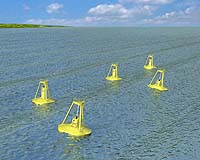 |
Durham NC (SPX) Nov 03, 2009 By taking advantage of the vagaries of the natural world, Duke University engineers have developed a novel approach that they believe can more efficiently harvest electricity from the motions of everyday life. Energy harvesting is the process of converting one form of energy, such as motion, into another form of energy, in this case electricity. Strategies range from the development of massive wind farms to produce large amounts of electricity to using the vibrations of walking to power small electronic devices. Although motion is an abundant source of energy, only limited success has been achieved because the devices used only perform well over a narrow band of frequencies. These so-called "linear" devices can work well, for example, if the character of the motion is fairly constant, such as the cadence of a person walking. However, as researchers point out, the pace of someone walking, as with all environmental sources, changes over time and can vary widely. "The ideal device would be one that could convert a range of vibrations instead of just a narrow band," said Samuel Stanton, graduate student in Duke's Pratt School of Engineering, working in the laboratory of Brian Mann, assistant professor of mechanical engineering and materials sciences. The team, which included undergraduate Clark McGehee, published the results of their latest experiments early online in Applied Physics Letters. "Nature doesn't work in a single frequency, so we wanted to come up with a device that would work over a broad range of frequencies," Stanton said. "By using magnets to 'tune' the bandwidth of the experimental device, we were able verify in the lab that this new non-linear approach can outperform conventional linear devices." Although the device they constructed looks deceptively simple, it was able to prove the team's theories on a small scale. It is basically a small cantilever, several inches long and a quarter inch wide, with an end magnet that interacts with nearby magnets. The cantilever base itself is made of a piezoelectric material, which has the unique property of releasing electrical voltage when it is strained. The key to the new approach involved placing moveable magnets of opposing poles on either side of the magnet at the end of the cantilever arm. By changing the distance of the moveable magnets, the researchers were able to "tune" the interactions of the system with its environment, and thus produce electricity over a broader spectrum of frequencies. "These results suggest to us that this non-linear approach could harvest more of the frequencies from the same ambient vibrations," Mann said. "More importantly, being able to capture more of the bandwidth makes it more likely that these types of devices could someday rival batteries as a portable power source." The range of applications for non-linear energy harvesters varies widely. For example, Mann is working on a project that would use the motion of ocean waves to power an array of sensors that would be carried inside ocean buoys. "These non-linear systems are self-sustaining, so they are ideal for any electrical device that needs batteries and is in a location that is difficult to access," Mann said. For example, the motion of walking could provide enough electricity to power an implanted device, such as a pacemaker or cardiac defibrillator. On a larger scale, sensors in the environment or spacecraft could be powered by the everyday natural vibrations around them, Mann said. Share This Article With Planet Earth
Related Links Duke University Powering The World in the 21st Century at Energy-Daily.com
 Wave energy moves to underwater grid link
Wave energy moves to underwater grid linkPennington, N.J. (UPI) Nov 2, 2009 The prospect of generating large volumes of electricity and then distributing power through underwater grid lines is nearer with successful tests announced Monday. New Jersey-based Ocean Power Technologies Inc. said it tested the feasibility of setting up wave power substations underwater and linking the pods to grids on land for onward transmission of the electricity to consumers. The ... read more |
|
| The content herein, unless otherwise known to be public domain, are Copyright 1995-2009 - SpaceDaily. AFP and UPI Wire Stories are copyright Agence France-Presse and United Press International. ESA Portal Reports are copyright European Space Agency. All NASA sourced material is public domain. Additional copyrights may apply in whole or part to other bona fide parties. Advertising does not imply endorsement,agreement or approval of any opinions, statements or information provided by SpaceDaily on any Web page published or hosted by SpaceDaily. Privacy Statement |